Wing Paddle Papers
[Editor: Al Bowers, a frequent contributor to the Yahoo surfski newsgroup, sent this infomation to me some months ago. I've only just got around to resizing the images & reformatting the text. Apologies Al!]
Recent discussions on wing paddles, their technique, and the method by which they work, have generated some differences in opinions and views. These are some of the only open literature data available on the topic. These data were from three sources, two from Ross Sanders and one from PS Jackson. The information is presented here with original statements (abstracts) from the papers, and some interpretation by this observer. No claim is made as to the accuracy or veracity of the data or the analysis or subsequent discussion. The data is presented only as information that may be used as basis for further exploration of the use of wing paddles. -Al Bowers (This email address is being protected from spambots. You need JavaScript enabled to view it.)
A Description of Olympic Kayak Stroke Technique
Ross H Sanders & Selina J Kendal, The Australian Journal of Science and Medicine in Sport, March 1992.
Recently, a new type of paddle, the 'wing' paddle, has been credited with improving the performance of elite Olympic flatwater kayak paddlers. This study was designed to compare technique across a range of abilities to determine factors which are associated with skilled performance using the wing paddle and to describe the path of the paddle. Five kayak paddlers ranging in ability from novice to elite were each filmed at 100 frames per secondfrom the lateral and frontal aspects while paddling at maximum speed. Among the variables determined from the digitized film record were boat velocity, stroke length, stroke frequency, and the path of the blade of the paddle. It was found that stroke frequency was associated with kayak velocity (p<0.05). The increase in stroke frequency with increasing performance was achieved by reducing both pull time (the time the paddle was in the water) and glide time (the time the paddle was out of the water). Differences in the path of the paddle were also apparent across the range of paddling abilities.
Table 1: Paddling experience, age, height and weight characteristics of the subjects.
Subject..Age...Height..Weight..Kayak..Wing
S1.........29....179.0...83.6....2.5 yrs..1 yr
S2.........29....175.5...89.2....3.5 yrs..2 yr
S3.........22....181.0...75.3....1.0 yrs..1 yr
S4.........23....174.5...75.7.....little...none
S5.........23....183.0...73.7.....little...none
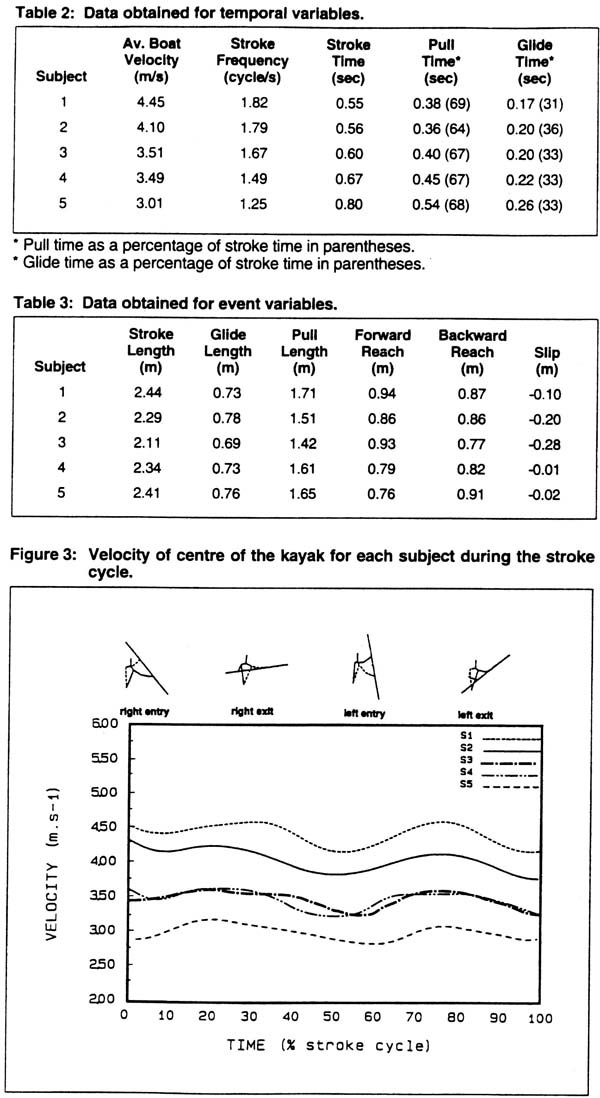
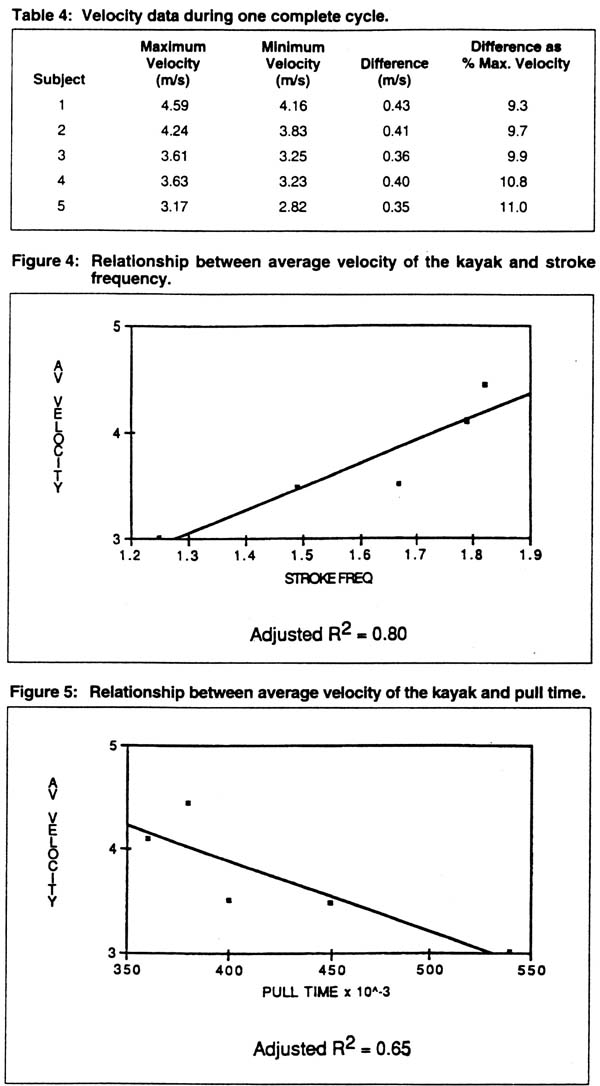
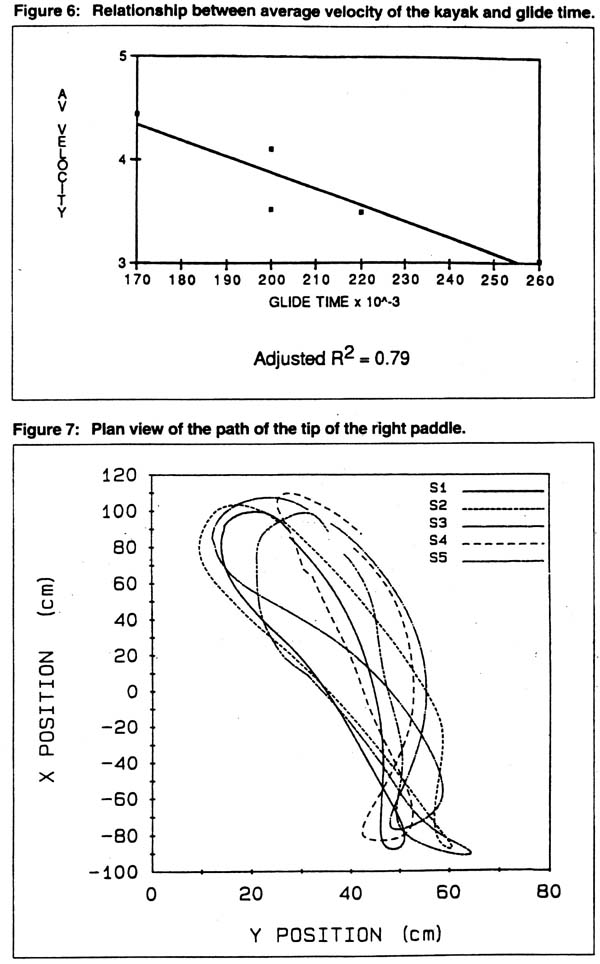
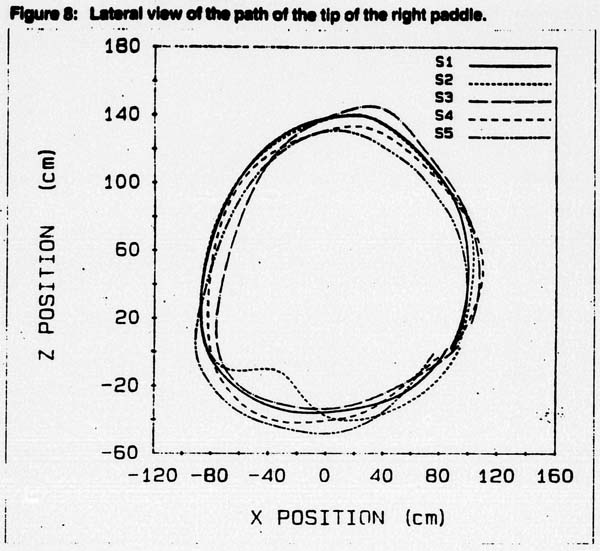
The Technique of Elite Flatwater Kayak Paddlers Using the Wing Paddle
Selina J Kendal & Ross H Sanders, International Journal of Sport Biomechanics, 1992, 8, 233-250.
The technique of elite New Zealand kayak paddlers using the Norweigian wing paddle was analyzed to identify factors leading to success. Five male New Zealand kayak paddlers were filmed with two high-speed cinematographic cameras. Paths of the blade tip and joint centers were determined from film data. Velocities ranged from 4.63 to 5.38 m/s. Stroke frequency ranged from 1.93 to 2.26 cycles/s. Results indicated that the more successful paddlers, based on previous competitive performances, had similar movement patterns and blade paths and that these differed from those of less successful paddlers. Their blade tip and joint center paths were more consistent across trials. More successful paddlers entered their blade well forward and closer to the longitudinal axis of the kayak than did less successful paddlers, and moved the blade a large distance laterally from the kayak and only a small distance backward with respect to the water.
Table 1: Mean scores for each subject's set of trials during the right-side stroke cycle (mean & standard deviation)
Subject..Av Vel.....Max Vel....Min Vel....delta....time to max (%) 1............5.38/0.08..5.55/0.09..5.31/0.07..0.25/0.06..25/1.03
2............5.14/----...5.45/----...5.02/----...0.43/----...26/----
3............4.97/0.05..5.24/0.06..4.88/0.07..0.44/0.10..21/1.03
4............4.77/0.06..4.98/0.13..4.61/0.04..0.34/0.08..25/0.71
5............4.71/0.18..4.88/0.13..4.52/0.09..0.44/0.08..28/0.65
Table 2: Mean scores for each subject's set of trials during the left-side stroke cycle (mean & standard deviation)
Subject..Av Vel.....Max Vel....Min Vel....delta....time to max (%) 1............5.29/0.07..5.49/0.06..5.11/0.04..0.36/0.03..29/1.32
2............5.06/----...5.41/----...4.79/----...0.62/----...26/----
3............4.03/0.05..5.31/0.04..4.59/0.01..0.72/0.04..29/0.63
4............4.63/0.07..4.98/0.06..4.53/0.07..0.28/0.03..21/2.93
5............4.65/0.09..4.83/0.06..4.41/0.08..0.42/0.06..31/0.87
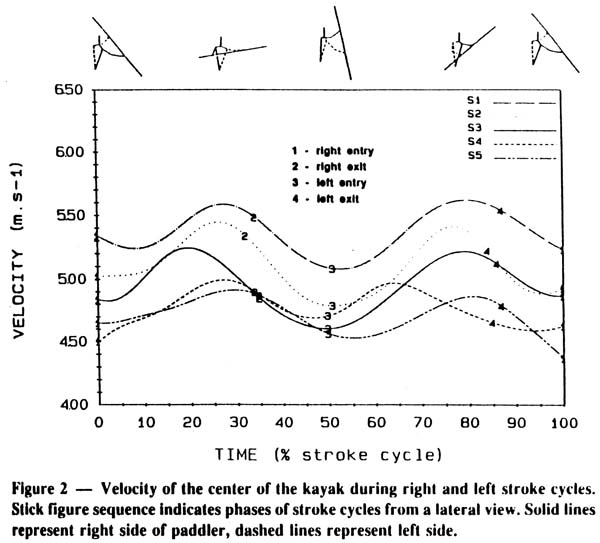
Velocity of the center of the kayak during right and left side stroke cycles. Stick figure sequence indicates the phases of the stroke cycles from a lateral view. Solid lines represent right side of paddler, dashed lines represent left side.
Table 3: Mean scores for each subject's set of trials (averaged over right and left stroke cycles, (%))
Sub..Av Vel..Stroke Freq..Stroke Time..Pull Time.......Glide Time 1.....5.33/0.09..2.26/0.02....0.44/0.00....0.30(70)/0.00(1.7)..0.13(30)/0.00(1.7)
2.....5.10/0.06..2.00/0.04....0.50/0.01....0.33(65)/0.01(2.0)..0.18(35)/0.02(2.0)
3.....5.00/0.06..1.96/0.02....0.51/0.01....0.36(71)/0.00(0.7)..0.15(29)/0.01(0.7)
4.....4.70/0.12..2.03/0.02....0.49/0.01....0.34(69)/0.01(0.7)..0.15(28)/0.00(0.7)
5.....4.68/0.16..1.93/0.02....0.52/0.01....0.37(72)/0.01(0.6)..0.15(28)/0.00(0.6)
Table 4: Mean scores for each subject's set of trials
Subject..Stroke.....Glide......Pull.......Fwd Reach..Back Reach..Slip 1...........2.36/0.02..0.70/0.04..1.66/0.04..0.92/0.03..0.75/0.08..-0.10/0.05 2...........2.49/0.01..0.88/0.08..1.68/0.01..0.99/0.00..0.75/0.00..-0.07/0.00 3...........2.55/0.03..0.74/0.02..1.81/0.01..1.08/0.03..0.88/0.02..-0.13/0.01 4...........2.32/0.04..0.71/0.02..1.61/0.02..1.03/0.03..0.78/0.06..-0.20/0.05 5...........2.43/0.01..0.67/0.02..1.76/0.02..1.03/0.05..0.93/0.05..-0.22/0.01
Table 5: Blade position with respect to X and Y axes during pull phase of right-side stroke cycle
Sub......entry x....entry y....exit x.....exit y.....displmt x...displmt y 1........0.92/0.01..0.51/0.02..0.82/0.03..1.07/0.01..-0.10/0.03..0.56/0.03 2........1.00/----...0.54/----...0.93/----...1.24/-----...0.07/----...0.70/---- 3........1.07/0.01..0.44/0.01..0.94/0.02..1.01/0.02..-0.13/0.01..0.57/0.02 4........1.03/0.01..0.63/0.02..0.83/0.01..0.99/0.03..-0.20/0.02..0.37/0.03 5........1.03/0.02..0.48/0.02..0.81/0.02..0.97/0.01..-0.22/0.01..0.48/0.01
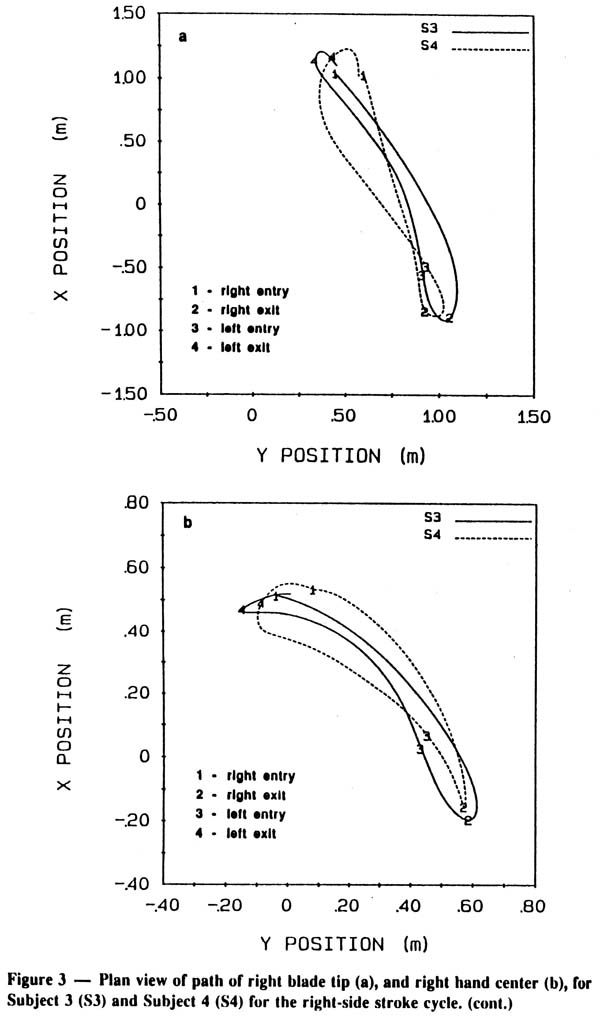
Plan view of path of right blade tip (a) and right hand center (b) for subject S3 and subject S4 for right-side stroke cycle.
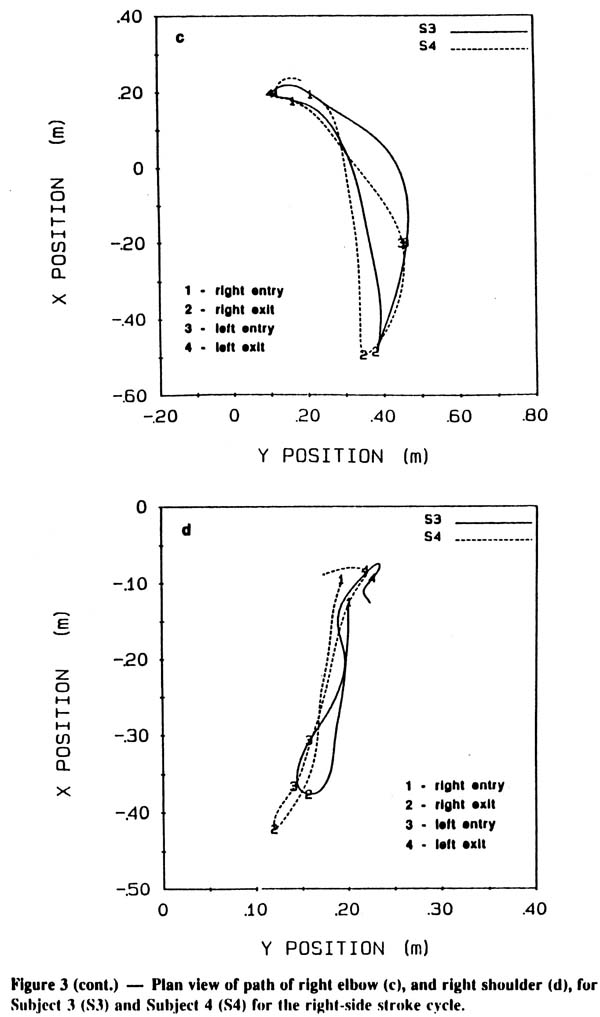
Plan view of path of right elbow (c) and right shoulder (d) for Subject 3 and Subject 4 for the right-side stroke cycle.
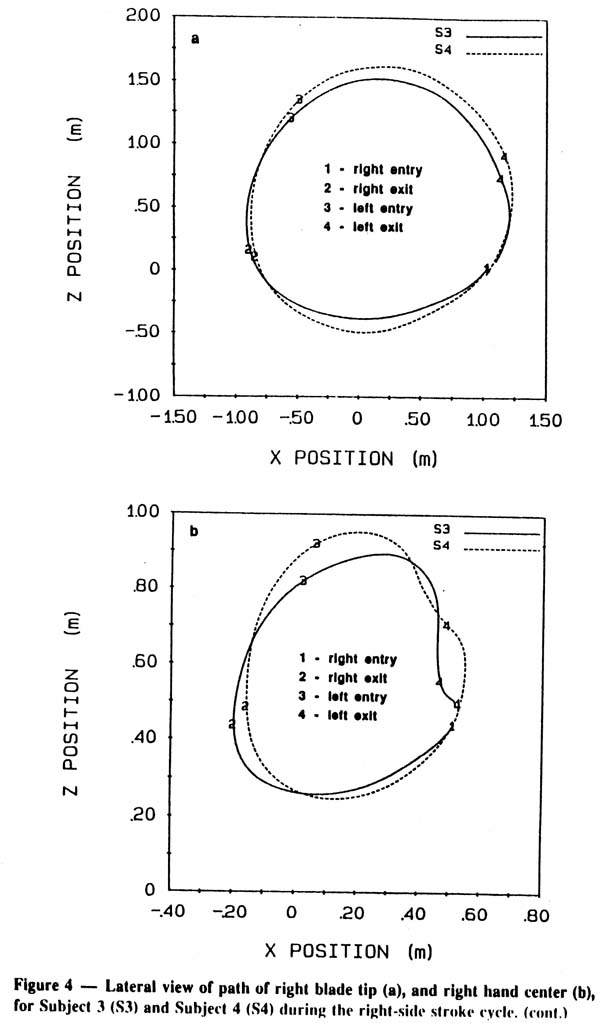
Lateral view of path of right blade tip (a) and right hand center (b) for Subject 3 and Subject 4 during the right-side stroke cycle.
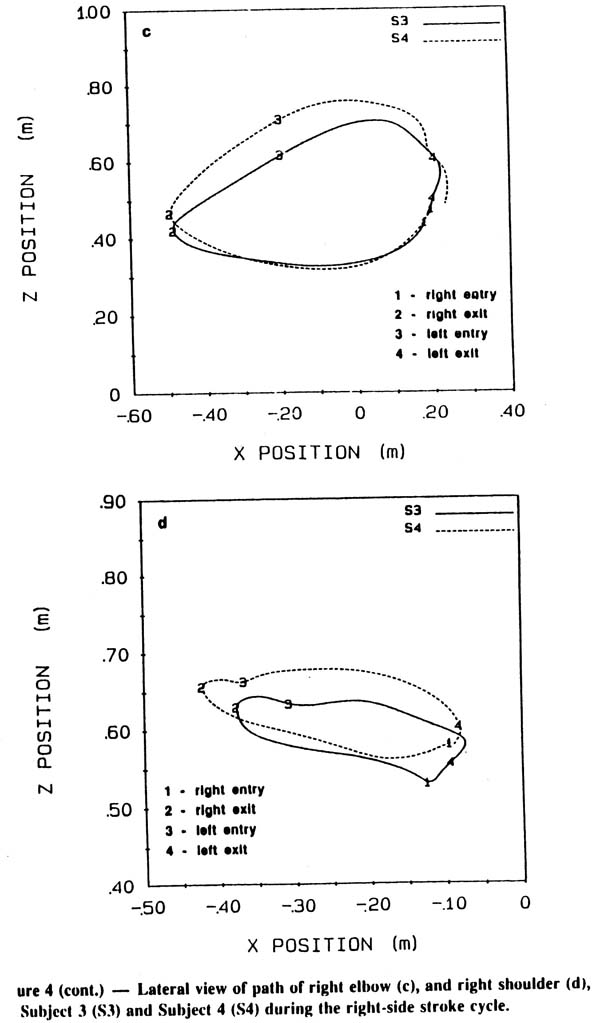
Lateral view of path of right elbow (c) and right shoulder (d) for Subject 3 and Subject 4 during the right-side stroke cycle.
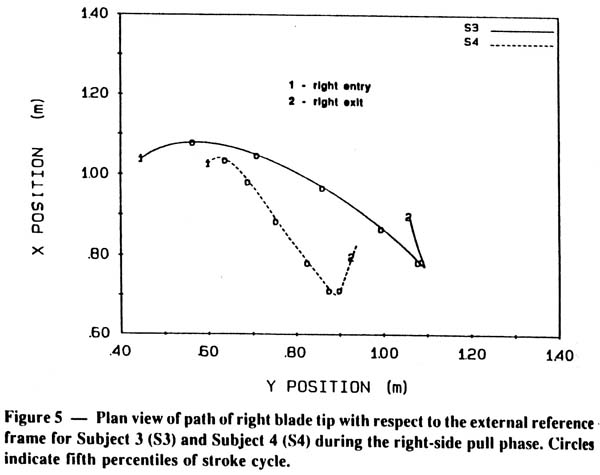
Plan view of path of right blade tip with respect to the external reference frame for Subject 3 and Subject 4 during the right side pull phases. Circles indicate fifth percentile stroke cycle.
Performance Prediction for Olympic Kayaks
P. S. Jackson Journal of Sports Sciences, 1995, 13, 239-245.
This paper sets out the effects of the various factors which determine the speed of racing kayaks and canoes, with the aim of identifying the areas most likely to lead to improvements. The friction, wave, and aerodynamic components of hull drag are first described in terms of the hull parameters, in order to provide accurate predictions of propulsive power as a function of hull speed. The generation of thrust by paddling is described via the mechanics of vortex-ring wakes, in oredr to determine the propulsive efficiency in terms of the parameters describing the blade and stroke. Equating the thrust and drag then leads to a predictive model for hull speed in terms of all the parameters describing hull and blade performance. This is used to determine the sensitivity of hull speed to small changes in each parameter, enabling the most important factors to be identified. The paper concludes with a discussion of various improvements to kayaks that have actually appeared in recent years, and uses earlier analysis to explain and predict the resulting speed changes.
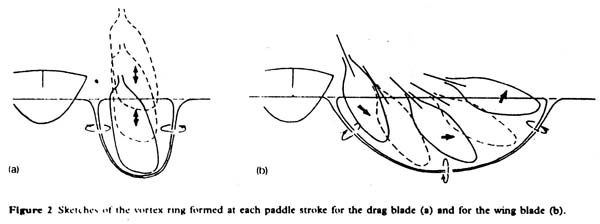
Sketches of the vortex ring formed at each paddle stroke for the drag blade (a) and the wing blade (b).
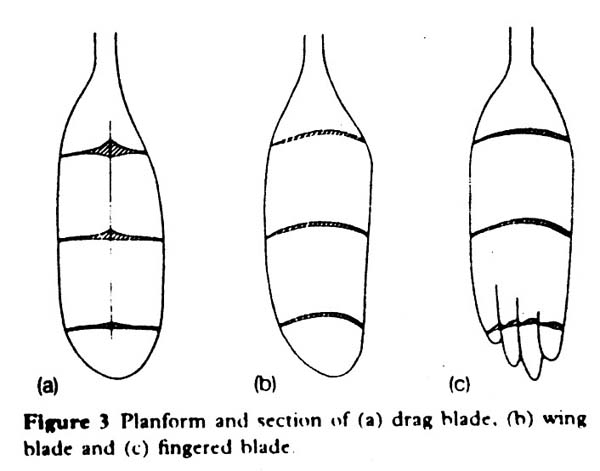
Planform and section of (a) drag blade, (b) wing blade, and (c) fingered blade.
Editorial Comments: Sander's two papers appear to point out that the key parameters for improved performance with wing paddles are 1/ high stroke rate (at least 90 strokes/min) and 2/ large lateral motion (at least 50 cm). The high stroke rate may be due to the early design wing paddles used in these studies (from the early 1990s), modern blades may not require such rates. Some of the "slip" in Sanders paper is due to the removal of the paddle from the water (a part of the exit) and may actually contribute to the "braking" on each stroke because the paddle is not still being pulled aft at the exit of each stroke). This may be a possible place for improvement. The hand motion data is also useful as it shows the upper hand crossing over the centerline being advantageous in nearly all cases, which establishes the paddle blade being placed in the water as close to vertical as reasonable.
Based on that data, and measuring a wing paddle, the Reynolds number is about 320,000 and about 2.5 to 3.0 lift coefficient. These are reasonable numbers as long as the stroke rate keeps the blade above the crtical Strouhal number (critical Strouhal is about 0.21, it is the rate below which the vortex flow breaks down and allows stalling and separation of the flow across the paddle blade). This critical stroke rate is about 70-80/min for most wing paddles. 1-D simulation shows these assumptions are reasonable and fall into the expected performance envelope of sprint kayakers.
Jackson believes that "fingered" blades could lead to improvement in efficiency. There is probably little or no improvement in efficiency. Slotted airfoils like this usually result in increased lift coefficient at the large expense of drag and a general decrease in efficiency (lift-to-drag ratio or L/D) compared to a solid blade. Given that the power output of humans is fairly limited (see below), efficiency (L/Dmax) is probably a more important driver to maximum speed than maximum lift coefficient (CLmax); the implication is that solid wing blades will remain more effective for kayak and surfski racing than slotted ("fingered") blades will. This may not necessarily be the case for the shortest race distances in sprint kayak (of 1 minute or less), where power outputs are higher and anerobic output may account for improved performance far more than aerobic performance. Note: the chart shows legs alone and total output. the difference between these curves is the added output for arms alone. However, the legs and torso are used in surfski and sprint kayak, so the output is above the difference between the curves, though how much is subject to some conjecture.
[Note: Selina Kendal, the student who worked with Dr Ross Sanders on the first two papers, has had her name appear on recent results sheets for the Molokai race, a gratifying case of theory and reality meeting by one of the foremost minds in wing paddles. -AHB]
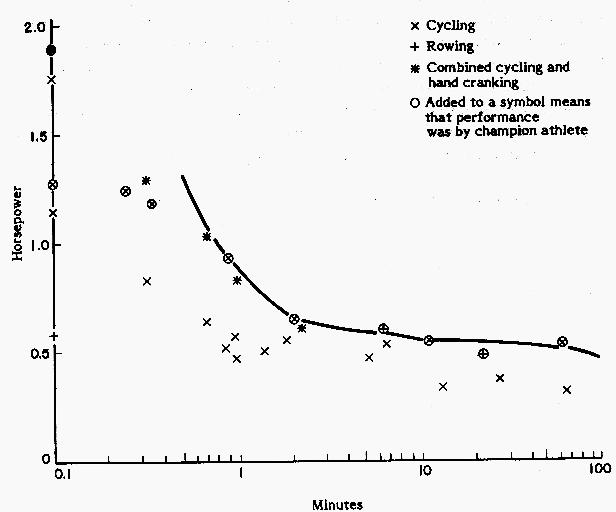
Additional resources for performance estimation: Toro, Andreas: "Canoeing: An Olympic Sport"; (book, out of print) 1985.
Endicott, William: "The Barton Mold"; US Canoe & Kayak Team, (book) 1996.
Sanders, Ross H; and Baker John D: "Evolution of Technique in Flatwater Kayaking"; Science & Practice of Canoe/Kayak, Pg 67-81, 1998.
Young, Ken: "Hydrodynamic Lift in the Sculling [Rowing] Stroke" http://courses.washington.edu/phys208/scull.lift.html, University of Washington.
Lausaskas, Leo: "Kayaks & Canoes" http://www.cyberiad.net/kayak.htm
Al Bowers This email address is being protected from spambots. You need JavaScript enabled to view it.

